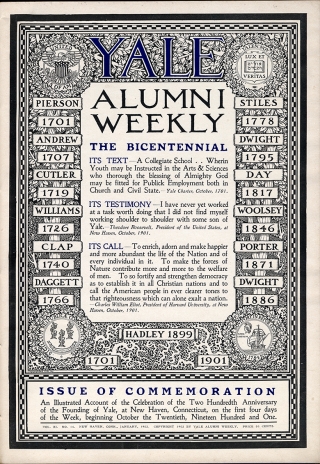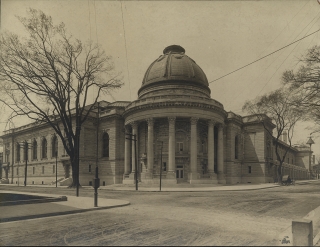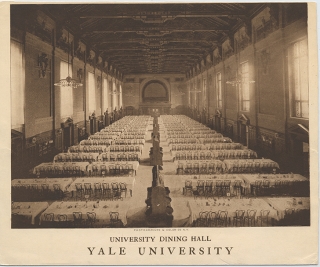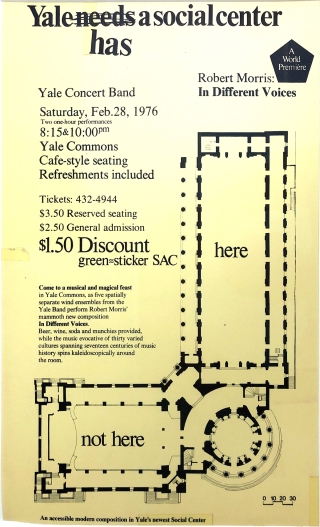Here you will find new and restored spaces for meeting, dining, and relaxing, and a host of ways to connect, create, and collaborate – all designed for students, faculty, and alumni from all of Yale’s schools and colleges. Welcome to YSC!
The YSC Story
The YSC Story
Welcome to the Schwarzman Center, Yale’s first-ever center for student life and the arts.
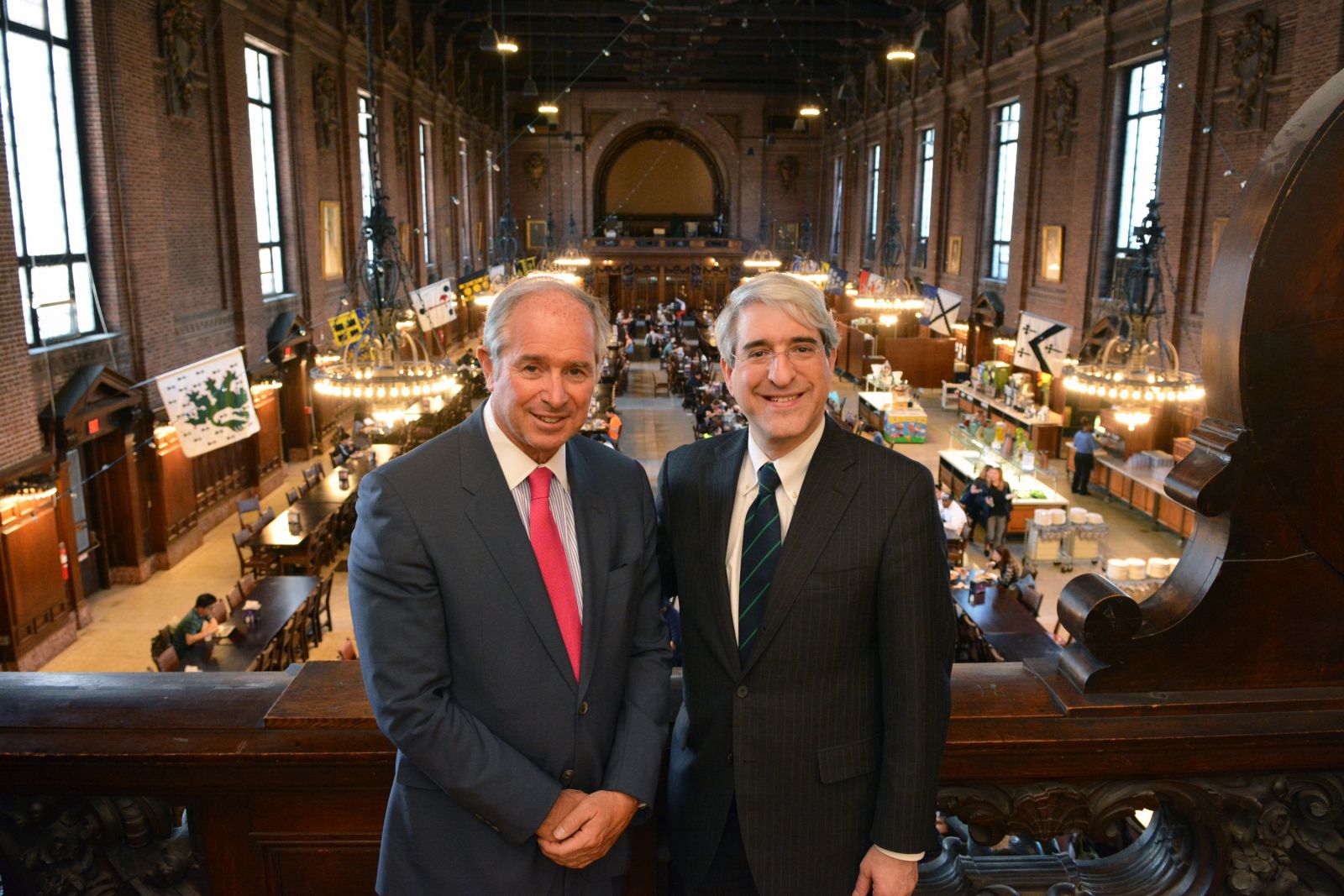
The Schwarzman Center will build on the strengths of our already-vibrant residential colleges and the communities within each of our schools and departments to inspire engagement in ways we can only begin to imagine.
A Brief History
By Ruhi Manek YC '20, Woodbridge Fellow
Over the course of many years, Commons has become a vital space for students, faculty, staff and the administration to define and redefine the significance of community and the meaning of well-being at Yale.
Yale University Commons first opened its baronial doors to the public in October of 1901 to commemorate the University’s 200th year anniversary. The cluster of Beaux-Arts style buildings, which strategically occupy the heart of Yale’s campus, aimed to unify a hitherto fragmented academic community between the colleges by Old Campus and the Sheffield Scientific School. Designed by architectural firm Carrère and Hastings, the Bicentennial Buildings were initiated under the administration of President Timothy Dwight (1886-1899), and completed under that of President Arthur Twining Hadley (1899-1921). Spaces include the Commons Dining Hall, the only dining facility not affiliated with one of the residential colleges; Memorial Hall, a domed, colonnaded structure honoring men of Yale who gave their lives in war; Woolsey Hall, an auditorium which holds the Newberry Memorial Organ, one of the largest in the world; and the Hewitt Quadrangle, a space long familiar to student organizing and activism. The interconnected structure stands adjacent to the University’s main administrative building, Woodbridge Hall.
Over the course of many years, the University Commons has been a vital space for students, faculty, staff and the administration to continually redefine the significance of community and the meaning of wellbeing at Yale. This culture dates to 1718 when ‘Yale College’ was erected on the corner of College and Chapel streets, the first combination dormitory and Commons of its kind. It was Yale’s first permanent building and included a library and chapel. Although it only hosted a handful of students, the establishment failed to prepare and provide quality dining, with reports citing “decidedly unbalanced” and “unappetizing” food[i]. Some students rebelled by throwing “over-ripe meat or rancid butter around the rooms or out the windows”[ii]; others, such as Samuel F. B. Morse of the Class of 1810, became intricately involved in the management of Commons. The Buttery, a series of favored late night student cafes and a vital part of present-day residential college life, once emerged as an appendage to the Commons before being abolished in 1817.
Commons has been a favorite object of undergraduate criticism at Yale for almost two centuries.
In Yale’s past, various attempts at institutional dining were made in the form of a Commons across Old Campus: in 1782, it was the site of what is now McClellan Hall, a copy of Connecticut Hall built in 1925 to serve as a freshman dorm; the second Commons occupied the first floor of the Philosophical Building, the Cabinet, in 1820; and, contemporaneously, the site of Chittenden Hall in 1827, where a library was eventually constructed in 1889[iii]. A lack of improvement in dining conditions made food riots and student mobilization frequent occurrences, eventually leading to the notorious “Bread and Butter Rebellion” of 1828[iv]. Students boycotted dining at any of the Commons, refused to attend recitations and skipped classes until demands were discussed.
By 1842, the idea of a Commons was abandoned completely, leading to the emergence of “eating clubs” around campus[v]. Students depended on each other to secure admissions to these joints, until college authorities began to furnish more equitable and affordable spaces. With the onset of the bicentennial and the merge between Yale College and the Scientific School in 1922, freshmen were required to dine at the Commons Dining Hall. For $3.25 a week, “linen, service, tea, coffee, cocoa, milk, bread and butter, fruit and vegetables” were made available[vi]. Anything extra could be ordered from an à la carte service. It was not until 1969, when women were admitted to Yale College, that the rules of a strict dress code, specifically a jacket and tie at meals, were relaxed.
Cora Colburn, the Head of Institution Economics and Director of the Commons at the University of Chicago, was Yale dining’s saving grace.
Post-WWI, Commons Dining Hall was in trouble once more. The establishment was dysfunctional, serving much below its capacity and running an economic deficit. The struggle for quality nutrition resurfaced and students reverted to private clubs and interpersonal arrangements. Cora Colburn, the Head of Institution Economics and Director of the Commons at the University of Chicago, was Yale dining’s saving grace. Summoned urgently by then President James Rowland Angell, Colburn enhanced the student experience at Yale by modernizing and improving the food, as well as permitting students for the very first time to make their own seating arrangements. Colburn exceeded the University’s expectations following the opening of the residential college dining halls in the 1930s, “serving 1,600,000 meals in 12 dining halls in 1938” alone[vii]. In 1927, she was awarded an honorary MA by the University—only the second of Yale professional women staff to receive one—and was recognized by the New York Times to be “one of the foremost designers of equipment for cooking and serving of food”[viii].
Following a series of temporary closures over the years, the University Commons closed for a final time in 2017, returning in the fall of 2020 as the Yale Schwarzman Center. It is designed to be a center for student life and the arts, fulfilling the need for a university-wide shared space that would “provide new opportunities for collaboration, mutual learning, and connection between students”[ix]. In September of 2014, the three student governments at Yale—the Yale College Council (YCC), the Graduate and Professional Student Senate (GPSS), and the Graduate Student Assembly (GSA)—together wrote to President Peter Salovey calling institutional attention to the need to bridge boundaries between undergraduate, graduate and professional students at Yale. The meticulous renovation of Commons and Memorial Hall (Woolsey Hall is not included in the renovation project) will thus make possible dynamic, technology-enabled crossroads for such socializing and cultural engagement. Through restored spaces for meeting, dining, and relaxing, the Schwarzman Center will advance a renewed sense of “One Yale” that the structure was originally intended for, by prioritizing creativity, collaboration and health within our communities.
Bibliography
Havemeyer, Loomis. Eating at Yale, 1701-1965. New Haven: Yale University, 1965.
Schiff, Judith Ann. “The Way We Ate.” Yale Alumni Magazine, December 1995.
Schiff, Judith Ann. “Uncommon Leadership.” Old Yale. Yale Alumni Magazine, March/April, 2019. https://yalealumnimagazine.com/articles/4840-cora-colburn
[i] Loomis Havemeyer, Eating at Yale, 1701-1965, (New Haven: Yale University, 1965), 10.
[ii] Havemeyer, Eating at Yale, 1701-1965, i.
[iii] Havemeyer, Eating at Yale, 1701-1965, i.
[iv] Judith Ann Schiff, “The Way We Ate,” Yale Alumni Magazine, December 1995, 80.
[v] Schiff, “The Way We Ate,” 80.
[vi] Havemeyer, Eating at Yale, 1701-1965, 20.
[vii] Judith Ann Schiff, “Uncommon Leadership,” Old Yale, Yale Alumni Magazine, March/April, 2019, https://yalealumnimagazine.com/articles/4840-cora-colburn.
[viii] Schiff, “Uncommon Leadership.”
[ix] The Schwarzman Center Advisory Committee, “Report to Yale President Peter Salovey” (Report, Yale, 2015), 3.

